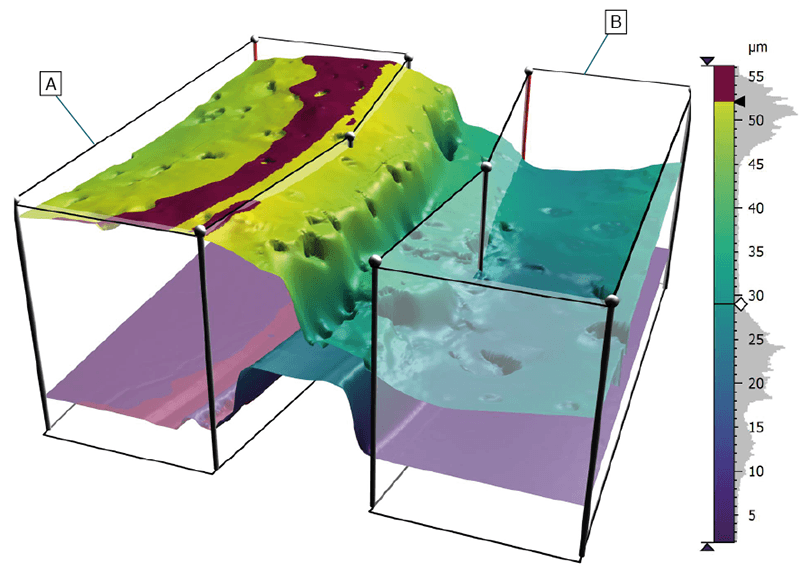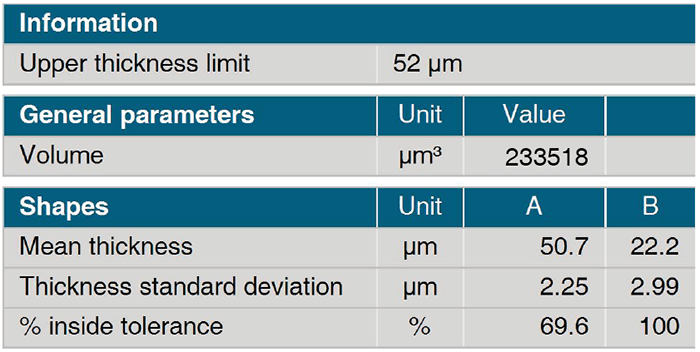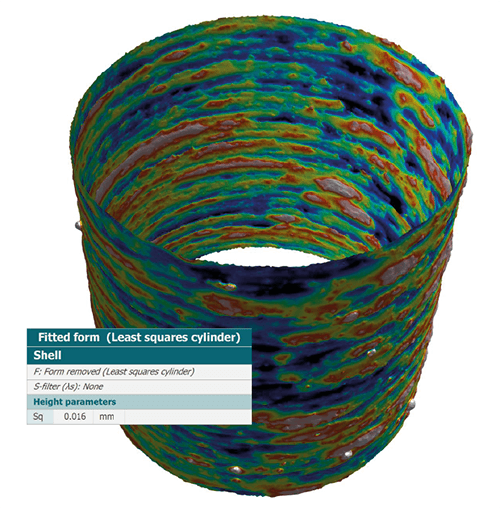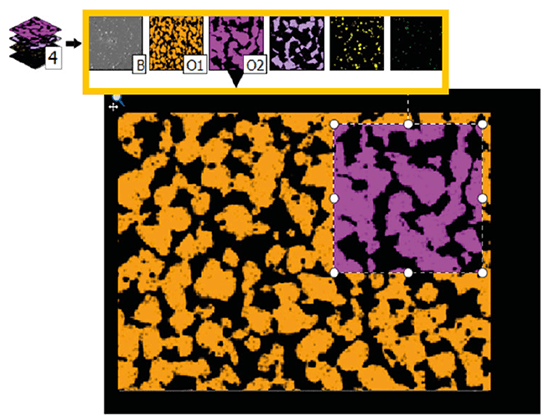Spring is upon us and with it a new version of Mountains® surface analysis software. In-person events have kicked off again, and the Digital Surf team will be proudly showcasing features included in the new release at the Control trade fair, taking place in Stuttgart May 3-6. Let’s preview some of the highlights!
A toolbox for analyzing thickness, wear & deposit
A major new element delivered with version 9.2 is an extensive range of features for users studying surface thickness.
Any two surfaces (measured simultaneously or not) can be aligned to form a “thickness pair” which can then be analyzed with regards global thickness parameters (mean, maximum/minimum, standard deviation etc.) or values at a specific point, along a line or over a zone.
Maximum/minimum thickness limits can be defined in order to graphically visualize “out-of-limit” zones.
Finally, users can generate stunning 3D thickness visualizations and cross-section them to get two-profile 2D analyses of membranes with interactive measurement cursors.


Above. Thickness analysis in 3D view mode
New Bandpass-filter bank operator
Characterizing samples at specific wavelengths allows better study of functional correlations. A Bandpass-filter bank Operator makes its debut in Mountains® 9.2, providing a way to apply multiple bandpass filters with increasing cut-offs.
The tool provides a new way to perform multi-scale analysis, as an alternative to wavelet analysis and scale-sensitive fractal analysis.
Read more: What is a bandpass filter and should I use it?
Contour analysis: extended options
Contour and Advanced Contour Analysis are extremely popular tools amongst Mountains® software users. In version 9.2, both modules have been enriched with:
- a new robust fitting method allowing users to exclude defects on measured components from calculations (see below);
- the ability to fit a circle with a fixed radius when comparing with nominal form;
- a new Settings dialog for improved usability.

Above. Left. Defects on the profile prevent correct circle fitting.
Right. With new robust fitting, defects are excluded and fitting is correct.
Shell (freeform surface) analysis comes of age
The latest release offers a number of new innovative features focused on the analysis of Shell (freeform surface) data. These include:
- automatic leveling of surfaces extracted from Shells or Point Cloud datasets;
- new Fit form Operator: fit a geometric form on a Shell to visualize form deviations (see below);
- quicker meshing of Point Clouds with automatic modes;
- improved mesh optimization on Shells;
- generation of Surface+Image studiables from Shells containing color information;
- conversion of Surfaces to Shells;
- conversion of Shells to Point Clouds.

Above. New Form fit operator on Shells. Data courtesy of Huddersfield University.
New for cross-technology
General usability improvements also feature heavily in version 9.2. Those working with very large datasets (several thousands or millions of pixels) will experience a faster, smoother experience as Mountains® algorithms have been dramatically optimized for this kind of processing.
Furthermore, data substitution, a well-loved feature allowing users to update an entire analysis document for another sample in one click, has been extended to studies using multiple studiables.
The Particle Analysis feature has been updated with new options for displaying Statistics by class, allowing comparison of values from different particle classes using statistical parameters.
Features for correlation, spectroscopy & SPM
Since its launch in version 9.0, MountainsSpectral® for correlation and spectroscopy continues to serve the needs of users processing data from spectroscopic techniques.
The Colocalization study continues to accommodate new features with improved automation features allowing users to manage axis settings, overlays and to manipulate layers more easily. Positioning methods and studiable size management have also been enhanced.
Similarly, multi-channel data manipulation has been made easier and noise elimination in spectral images has been enabled by a “set minimum value to zero” tool.
Two new Operators await users of Scanning Probe Microscopy: Derive Operator on IV curves/spectra and Adjust Z-offset for more meaningful comparisons between studiables.

Above. Colocalization thumbnails allow easy layer management.
How to update
Access to the new version is free for users with an active Mountains® Software Maintenance Plan (SMP). Please visit our Software Updates page.
To find out more about your Maintenance options, please contact sales@digitalsurf.com.